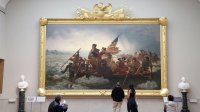How to Use Art to Teach History
A piece of art can provide a window into a historical time period for students.
Your content has been saved!
Go to My Saved Content.Art is an important and perhaps unexpected tool in teaching history. Photos, drawings, and paintings can communicate an abundance of information about historical events. Students can analyze pieces of art to assist them in digging deeper into investigating an artist’s perspective and decision-making.
Provide students with the knowledge and time to learn how an artist’s techniques impact how we interpret historical events to help students become better historical thinkers and create deeper civil discourse. By making observations, asking questions, and sharing connections between art and history, students gain knowledge about history.
Select Works of Art
When choosing art for students to examine, first decide how the art will be incorporated in the lesson. For example, a piece of art can be an exciting way to introduce a new historical topic to students. When choosing which art to use, assess the degree of familiarity that students may have with the content of the work. Consider whether the art expresses a reaction to a historical decision and ways it might be used to frame a discussion about why people had those reactions and their responses.
Explore a range of media types. For example, a political cartoon can be a useful entry point for students who are less familiar with formal art. Three-dimensional work, such as a sculpture, offers variety. Avoid work that is too abstract, as it may be difficult for beginning students to comprehend. Consider works from artists of varying backgrounds.
Don’t limit the work to one piece. Multiple pieces may be beneficial in helping students investigate how a person or event was perceived in the historical period and today. Look for pieces that represent multiple perspectives so that students have the opportunity to grapple with the artists’ decisions. Selecting works that use several artistic techniques will allow for a more robust discussion of the connections that students can make between the work and history.
In making decisions about what art to use, consider supplemental materials that may help bring the work to life. Texts about interpretations of the work can be a helpful tool to scaffold learning. Lesson plans, supportive texts, and accompanying guided questions are readily available online through organizations such as the Metropolitan Museum of Art and the National Gallery of Art to support integration of art history into classrooms.
Model the Process
Model how to study art in detail to convey expectations for how students should approach the same practice.
For example, I walk students through an interpretation of the painting Washington Crossing the Delaware, by Emanuel Leutze. In this painting, George Washington is leading the Continental Army across the Delaware River to carry out an attack on Hessians. Leutze used various compositional techniques to define Washington as a leader while also allowing observers to interpret the painting for themselves.
Point out techniques in the work of art. Students will have their own opportunity to interpret the painting for themselves and reach their own conclusions, not only about the artist’s perspective but also about how it relates to the study of history.
Offer several elements for students to consider to analyze the visual composition of a painting:
- Color: Using different colors, especially those that contrast, can communicate how one may feel about a person, event, or idea.
- Framing: Ask students to examine how surrounding features create a frame around the main focus of the picture. In the Washington Crossing the Delaware example, Washington is surrounded by his soldiers, ice, and the flag, encouraging viewers to remain focused on his depiction.
- Symbolism: Encourage students to think about what something stands for more than what it just appears to be.
- Body language: Positioning and facial expression can communicate how a subject feels within the photo, drawing, or painting.
- Lighting and shadow: Amounts of light and dark can present information regarding something that occurred or will happen in the future.
Connect to History
After students understand the specific techniques used in a piece of art, explain how it may relate to historical events. Outline the learning goal for students at the outset. Be prepared to share pieces of information about the historical event as the students begin their task. Some students will be able to take the discussion in the direction you want, while others can benefit from guided questions to help focus their observations.
Begin with the basics by asking students to assess what the artwork tells them about the time period or individual. Then ask them to evaluate the artist’s choices in how they created the image. What techniques did they use to convey different points of view? What do the techniques used reveal about the historical period? Are there omissions in the artist’s work that reveal information about the time period?
For example, once students understand the technique of framing, they can consider what surrounds the main subject of the picture to create a frame instead of looking at these parts independently without any connection to one another. After students evaluate the artist’s choices, they can begin to interrogate the artist’s motive, the perspectives expressed, and the facts and omissions about the event itself. In Washington Crossing the Delaware, framing brings the flag to the viewer’s attention. Students can use that observation to respond to the prompts to gain insight on the historical significance of the work.
Once students have assessed the individual piece of art and the artist, ask them to consider the piece in the context of other works at the time. Providing other contrasting examples of art from the time period can help reinforce learning about the time period.
